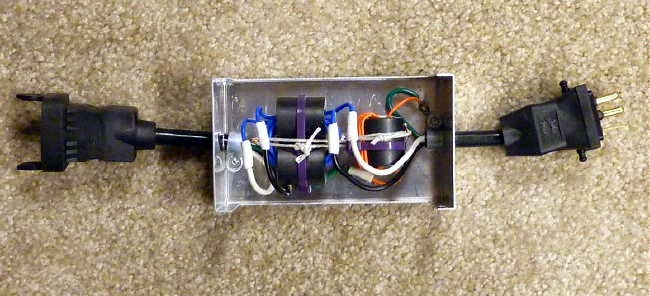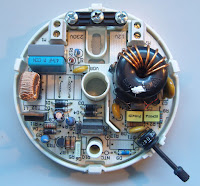Posts Tagged ‘noise’
 More Low Noise Vertical Info
More Low Noise Vertical Info
The first video shows phasing against local IBOC crud.
The second video shows the phaser in use to knock down the sideband hash from a strong local (KOA) signal, 25 miles away.
For those that like to DX in real time (unlike those using SDR overnight samplings), the phaser has much to offer.
The one being used in the videos is the Quantum Phaser and more information about it may be found here.
More on phasers next time.
 House Number Four – Update
House Number Four – Update

Regular readers will likely recall my early January blog describing the sudden and very unwelcome appearance of a severe noise problem badly affecting my LF reception. I had spent an afternoon D/F'ing the noise source (which was being radiated via the local power lines), only to discover that the residence in question was not occupied ... and has been vacant for the past seven weeks as the noise continued.
 |
| The culprit |
Yesterday I noticed that the home was once again occupied and this morning, with radio in hand, I paid visit. It seems that the part-time residents had been spending the past several weeks in Hawaii and had just returned to the house to check up on things. I explained to the owner what I believed to be the problem and, as suspected, it was a CFL light ... a particularly noisy one. Turning the light on and off quickly verified the culprit light and swapping the bulb out for a different one produced no observable noise, as was the case for one that had been left switched-on in the living room.
Whether the offending bulb was just a poorly designed one, a very early manufactured model or one that was about to fail, I do not know ... but I am amazed at the strength of the QRN (and QRM) that the bulb was able to produce at such a distance, about ten properties away!
 |
| CFL Crud on LF |
The owner was very concerned that he had unknowingly caused a problem and was very apologetic, as I have found with similar situations in the past.
One of the worst was also a CFL bulb that had actually burned-out and was located in a nearby (three properties away) crawl space. When finally traced, the bulb was heavily charred and had partially melted at the base, yet was still producing an ear-shattering level of crud right into the HF spectrum.
In cases like these, it is often difficult to get an accurate D/F on the signal through normal means since the signal is being propagated via the overhead powerlines. Attempts to D/F the signal almost always point to the closest powerline and not to the signal source. Usually such a noise generator will be confined to your local power grid ... that is, the homes that are powered between the two large power distribution transformers in your local neighborhood. In my case, this limits the search to about 15 homes.
I have found that the best way to tackle this is to make a 'noise map' and to try and measure the noise intensity at a similar point for each property - ie. directly beneath the powerline as it enters the property. This will usually put you at the same vertical distance from the line and will give you a better noise sample that is directly (or not) associated with that property. After mapping this out, if the culprit property is not obvious, then you will at least have narrowed it down to a very few choices. Other types of noise, that can be detected into the VHF range, are probably best detected using normal D/F methods.
After bringing the offending bulb home, I Google-searched the product name and number and came up with a 'product recall' for this particular model.
"According to a Health Canada and Electrical Safety report, the lamp may overheat and melt the enclosure exposing live parts, posing a risk of fire and/or electric shock."
Apparently they were indeed manufactured incorrectly and it's just as well that it was found and removed before causing serious damage!
Once again LF sounds as it should. Hopefully it can remain this way for a long time but with the proliferation on noise-making appliances and 'improvements', I have my doubts.
 Grow Light Noise?
Grow Light Noise?
 |
| Courtesy: http://tomthompson.com/radio/projects.html |
Another type of noise problem was addressed in a posting to the topband reflector today by Don, WD8DSB.....the noise coming from a treadmill's, PWM speed-controlled DC motor.
" For many years my wife's treadmill caused strong interference on 160 meters when it was in use, and yesterday I was able to completely eliminate the RFI using a combination of two different filters (a commercial line filter that provides both common mode and differential mode filtering, and 14
turns of the power cord on a 2.4" OD Fair-Rite #31 mix toroid core based on
the K9YC hams guide to RFI document).
I created a simple website that documents my tests and the filters used,
and for those interested the website URL is:
http://sites.google.com/site/treadmillrfi/
The website contains a link to a video on youtube where you can actually
see the effectiveness of the filters. "
These two amateurs have developed slick solutions to their noise problems, but sadly, noise ingression is rising exponentially it seems and is becoming more and more challenging to mediate.
 Found it!
Found it!
The source of all my Faros problems…..The netbook itself. I hadn’t actually checked the obvious and that was what it was. The noise generated by the netbook was stopping it from finding signals in all the noise. Hence the 100% QSB. When I disconnected and unplugged everything the noise level dropped massively and that was the end of the problem.
Trouble is I sort of need that to run the program. Oh well, I suppose I can try and run it under wine with Linux and put it on the RPI as that makes little or no noise. I feel some hours being used up ahead!
 Visiting 409shop in Hong Kong
Visiting 409shop in Hong Kong
A stop-over on my way from Sydney to Oslo gave me the opportunity today to visit Apliu street in Hong Kong. This is where all the electronics products are found. As I had purchased a Baofeng UV-5R from them before it was fun to stop by the 409shop as well. Their address is on their web site, and the word “showroom” really made me expect something larger than what I found. It turns out to be just one small store among hundreds of others in this street.
I bought a handheld frequency counter, Yaege FC-1, and a better antenna, Nagoya NA-666, for the UV-5R and got a good deal – I like to think that it is because I presented myself as a previous internet customer.
On the other side of the street there was another store with communications equipment as well, Yee Fu Technology Shop, where I bought a 13.8V/20 A switch mode power supply, HK Products Electronics SPS-200MA.
It even had a noise-offset control which I have come to appreciate in my other power supply, the Alinco DM-330MV. It is particularly nice to have on 160 m. How they avoid Alinco’s pending patent on this feature is something I don’t know. There seems to be several other supplies on the market with this feature also, such as the Watson Power-Mite-NF (NF for Noise offset Function), so maybe Alinco’s patent application hasn’t been granted?
 Noisy Designer Lamp
Noisy Designer Lamp
 |
| Herstal pendant lamp, type 06 |
Some years ago I had this annoying noise that made listening for weak signals on several of the shortwave radio bands virtually impossible. In the end I was finally able to track down the noise source: Our beautiful Danish Herstal designer lamps in the kitchen. Actually it wasn’t the lamps themselves, but the dimmable switch mode power supply that came with them.
After some years of always having to remember to turn them off, in the end I just replaced the original noisy dimmer with a fixed voltage, noiseless, electronic transformer and inserted lower wattage 12 V light bulbs in the two lamps.
The original dimmer came in its own nice conical designer housing and inside one finds a more ordinary plastic housing. And of course it is marked with the CE mark, thus indicating that it should be fine with respect to noise. But as I kept opening it up, I finally found the printed circuit board. Interestingly, there are several components which have just been bypassed with wires. The most important one must be the one to the left of the center hole. Here two wires have replaced a component connected more or less directly to the 230 V AC input.
But as I kept opening it up, I finally found the printed circuit board. Interestingly, there are several components which have just been bypassed with wires. The most important one must be the one to the left of the center hole. Here two wires have replaced a component connected more or less directly to the 230 V AC input.
I believe this is a common mode filter. These filters hardly serve any purpose when it comes to the function of the dimmer. But they are vital for ensuring that the dimmer does not radiate noise on the power line, and probably also for achieving the CE mark.
 |
| Press for larger image |
I think the manufacturer, Herstal, may have cut some corners here in order to save cost. They seem to have fallen for the temptation to remove this filter component after it initially had been designed in.
Who at Herstal who made that decision, I can only speculate about. But since the filter initially was there, I think that it was someone other than the design engineers.












